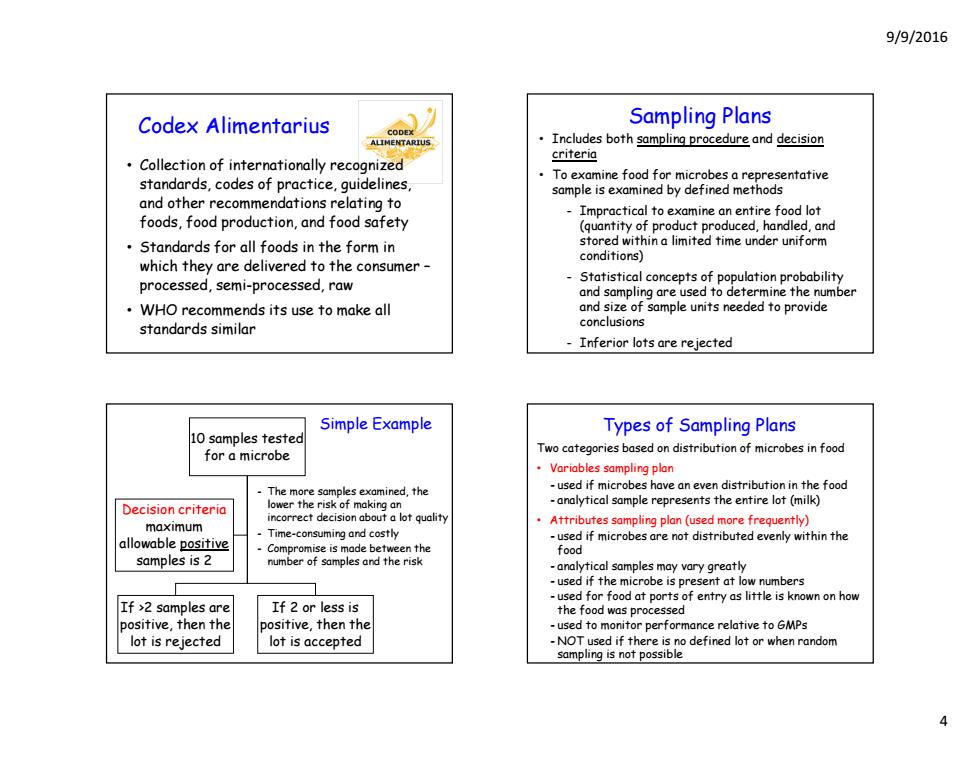正在加载图片...

9/9/2016 Codex Alimentarius Sampling Plans Includes both sampling procedure and decision criteria Collection of internationally recognized standards,codes of practice,quidelines, To examine food for microbes a representative sample is examined by defined methods and other recommendations relating to Impractical to examine an entire food lot foods,food production,and food safety (quantity of product produced,handled,and Standards for all foods in the form in stored within a limited time under uniform conditions) which they are delivered to the consumer -Statistical concepts of population probability processed,semi-processed,raw and sampling are used to determine the number WHO recommends its use to make all and size of sample units needed to provide standards similar conclusions Inferior lots are rejected Simple Example Types of Sampling Plans 10 samples tested for a microbe Two categories based on distribution of microbes in food Variables sampling plan The more samples examined,the -used if microbes have an even distribution in the food -analytical sample represents the entire lot(milk) Decision criteria lower the risk of making an incorrect decision about a lot quality maximum Attributes sampling plan (used more frequently) allowable positive Time-consuming and costly -used if microbes are not distributed evenly within the Compromise is made between the food samples is 2 number of samples and the risk -analytical samples may vary greatly -used if the microbe is present at low numbers used for food at ports of entry as little is known on how If >2 samples are If 2 or less is the food was processed positive,then the positive,then the -used to monitor performance relative to GMPs lot is rejected lot is accepted -NOT used if there is no defined lot or when random sampling is not possible 49/9/2016 4 Codex Alimentarius • Collection of internationally recognized standards, codes of practice, guidelines, and other recommendations relating to foods, food production, and food safety • Standards for all foods in the form in which they are delivered to the consumer – processed, semi-processed, raw • WHO recommends its use to make all standards similar Sampling Plans • Includes both sampling procedure and decision criteria • To examine food for microbes a representative sample is examined by defined methods - Impractical to examine an entire food lot (quantity of product produced, handled, and stored within a limited time under uniform conditions) - Statistical concepts of population probability and sampling are used to determine the number and size of sample units needed to provide conclusions - Inferior lots are rejected 10 samples tested for a microbe If >2 samples are positive, then the lot is rejected If 2 or less is positive, then the lot is accepted Decision criteria maximum allowable positive samples is 2 Simple Example - The more samples examined, the lower the risk of making an incorrect decision about a lot quality - Time-consuming and costly - Compromise is made between the number of samples and the risk Types of Sampling Plans Two categories based on distribution of microbes in food • Variables sampling plan - used if microbes have an even distribution in the food - analytical sample represents the entire lot (milk) • Attributes sampling plan (used more frequently) - used if microbes are not distributed evenly within the food - analytical samples may vary greatly - used if the microbe is present at low numbers - used for food at ports of entry as little is known on how the food was processed - used to monitor performance relative to GMPs - NOT used if there is no defined lot or when random sampling is not possible